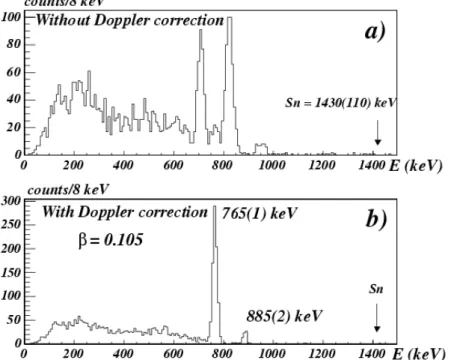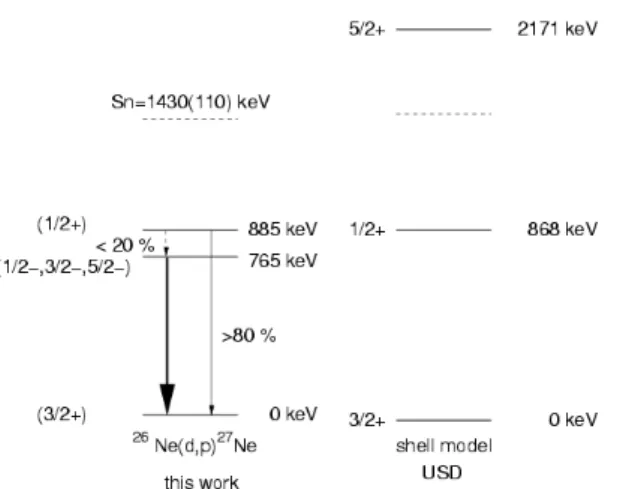HAL Id: in2p3-00087146
http://hal.in2p3.fr/in2p3-00087146
Submitted on 4 Jan 2007
HAL is a multi-disciplinary open access archive for the deposit and dissemination of sci-entific research documents, whether they are pub-lished or not. The documents may come from
L’archive ouverte pluridisciplinaire HAL, est destinée au dépôt et à la diffusion de documents scientifiques de niveau recherche, publiés ou non, émanant des établissements d’enseignement et de
Shell Gap Reduction In Exotic N = 17 Nuclei
A. Obertelli, N. Alamanos, M. Alvarez, F. Auger, R. Dayras, A. Drouart, G.
de France, A. Gillibert, B. Jurado, N. Keeley, et al.
To cite this version:
A. Obertelli, N. Alamanos, M. Alvarez, F. Auger, R. Dayras, et al.. Shell Gap Reduction In Exotic N = 17 Nuclei. Frontiers in Nuclear Structure, Astrophysics, and Reactions - FINUSTAR, Sep 2005, Isle of Kos, Greece. pp.177-180, �10.1063/1.2200921�. �in2p3-00087146�
Shell Gap Reduction In Exotic N = 17 Nuclei
A.Obertelli
1, N.Alamanos
1, M.Alvarez
1, F.Auger
1, R.Dayras
1, A.Drouart
1,
G. de France
2, A.Gillibert
1, B.Jurado
2, N.Keeley
1, V.Lapoux
1, W.Mittig
2,
X.Mougeot
1, L.Nalpas
1, A.Pakou
3, N.Patronis
3, E.Pollacco
1, F.Rejmund
2,
M.Rejmund
2, P.Roussel-Chomaz
2, H.Savajols
2, F.Skaza
1, Ch. Theisen
11- DSM/DAPNIA/SPhN, CE Saclay, F- 91191 Gif sur Yvette, France 2 - Ganil BP 5027, F-14076 Caen Cedex 5, France
3 – Department of physics, The University of Ioannina, 45110 Ioannina, Greece
Abstract. 27Ne has been investigated through the one neutron transfer reaction 26Ne(d,p)27Ne in
inverse kinematics at 9.7 MeV/nucleon. The results support the existence of a low lying negative parity state in 27Ne which is a signature of a reduced sd-fp shell gap in the N=16 neutron rich
region, at variance with stable nuclei.
Keywords: Transfer reaction, inverse kinematics. PACS: 21.10.Pc, 25.60.Je, 25.70.Hi, 27.30+t, 29.30.Kv;
N = 16 has been recently suggested to be magic near the neutron drip line, both theoretically [1] and experimentally [2]. This may arise from an enhancement with isospin of the gap between the s1/2 and d3/2 subshells of the sd neutron shell. The study of the single particle excitations in N = 17 isotones is well suited to determine the spacing between the d3/2 subshell and the fp shell. The lowest excitation energies of the negative parity states for the most bound N = 17 isotones (35Ar, 33S and 31Si) are quite high, around 3.5 MeV, but below 1.5 MeV for 29Mg [3]. The next N = 17 isotone is 27Ne for which very little [4] information are available.
We used the Spiral beam 26Ne at 9.7 MeV/nucleon of the GANIL facility to study the one neutron transfer 26Ne (d,p) 27Ne in inverse kinematics on a 1 mm thick solid cryogenic deuterium target [5]. The ejectiles were detected and identified with the VAMOS magnetic spectrometer [6]. Due to the large momentum acceptance and the inverse kinematics, not only 27Ne was transmitted, but others ejectiles simultaneously observed in the focal plane from others reaction channels like (d,d’) or (d,t). A complete identification was obtained with usual combinations of time of flight, energy loss and transverse position in the focal plane (fig.1). Due to the target thickness, the recoiling protons emitted at backward angles in the lab frame were not measured.
In coincidence, the emitted photons were measured with part of the EXOGAM spectrometer in a compact geometry around the target. We used 11 clovers, placed at distances varying from 11 to 17 cm from the center of the target in three different rings depending on the polar angles θ = 45, 90 and 135 degrees in the laboratory frame. The intrinsic resolution of the whole system was measured to be 2.6 keV (FWHM) at 1332 keV, and the photopeak efficiency was estimated to be 4.8 %.
FIGURE 1. Final identification of the ejectiles in the focal plane of the VAMOS spectrometer in
coincidence with the photons emitted in the EXOGAM spectrometer.
As the reaction vertex in the target is not reconstructed, only a mean value of the relative velocity β = v/c may be used. For 27Ne and the (d,p) channel, a mean value β = 0.105 was adopted, for which the measured energies are equally well corrected for the Ge detectors at backward and forward angles.
FIGURE 2. Energy spectrum of photons measured in coincidence with 27Ne in the VAMOS
spectrometer (a) without and (b) with Doppler correction resulting in two transitions at 765 and 885 KeV. The Doppler shift effect is especially visible for the intense 765 keV transition on (a) with 3 peaks corresponding to the 3 rings at 45, 90 (with a much lower efficiency due to the target) and 135 degrees.
Below the neutron emission threshold S1n = 1430 (110) keV, two transitions are observed at 765 and 885 keV on the Doppler-corrected spectrum (fig.2b). Within the
limited statistics, we did not observe any coincidence between these transitions. Due to the low S1n value, it is the most likely that these transitions directly connect two excited states to the ground state as shown on fig.3. We did not observe a strong evidence for a transition at 120 keV over the background, connecting the 885 keV state to the 765 keV state. An upper limit of 20% was deduced for the branching ratio τ of such a transition, compared to the direct decay to the ground state. Finally, that transition was observed in a recent knock-out experiment done at MSU with a 28Ne beam, which validates the proposed scheme on fig.3 (left part). On the right part are shown the predictions of the USD shell model [7] for the positive parity states of 27Ne. Only one positive parity state is predicted below the neutron threshold, with spin 1/2+. The two experimental levels are consistent with that state, so that one of themmight be a negative parity state.
E (keV) σ (mb) τ = 0% σ (mb) τ = 20%
0 gs 4.6 (3.9) 4.6 (3.9)
765 21.9 (2.3) 21.3 (2.3)
885 2.5 (0.5) 3.1 (0.6)
Table 1 : Experimental integrated cross sections for two different values of the branching ratio τ, 0 and 20%, for the decay of the 885 keV state as shown on fig.3
To go further, we performed calculations with the code FRESCO using the CDCC (Continuum Discretized Coupled Channels), CRC(Coupled Reaction Channels) and CC (Coupled Channels) formalism [8], taking into account the deuteron break-up. The results are in good agreement with the experimental values seen in table 1 with a large spectroscopic factor for the 765 keV state, whatever the transferred angular momentum may be (∆ℓ= 1 or 3). Due to the large uncertainties, no direct assignment was done for ∆ℓ.
FIGURE 3. Spectroscopy of 27Ne bound states (left part) observed in the one neutron transfer 26Ne(d,p)27Ne compared to the USD shell model predictions (right part).
Under the assumption consistent with the USD shell model that the ground state is Jπ = 3/2+, our data are consistent with a 1/2+ state at 885 keV. A negative parity state at 765 keV may be 1/2-, 3/2-, 5/2- or 7/2-. However, a 7/2- state would decay to the ground state via a M2 transition, resulting in a strong anisotropy forward/backward in the γ-ray emission not seen in the data, which excludes the 7/2- spin. A 5/2- parity is not excluded by our data, however it would strongly favor a direct decay (M1+E2) of the 885 keV state 1/2+ to the ground state compared to a slow 120 keV M2 transition to the 5/2- state. A summary of our analysis is shown on fig.3.
The low-lying fp shell orbits, suggested for 29Mg and observed in this work for 27Ne, can have two origins : a smaller spherical energy gap between the d3/2 subshell and the fp shell and (or) deformation.
REFERENCES
1. T. Otsuka et al., Phys. Rev. Lett. 87, 082502 (2001); A. Obertelli et al., Phys. Rev. C 71 024304 (2005), 2. A. Ozawa et al., Phys. Rev. Lett. 84, 5493 (2000),
3. L.K. Fifield et al., Nucl. Phys. A 437, 141 (1985); P. Baumann et al., Phys. Rev. C39, 626 (1989),
4. M. Belleguic-Pigeard de Gurbert, Ph.D Thesis, Université Lyon I, 2000; H. Iwasaki et al., Phys. Lett. B 620, 118 (2005),
5. A. Obertelli et al., to be published in Phys. Lett.B,
6. H. Savajols & the VAMOS collaboration, Nucl. Phys. A 654, 1027c (1999), 7. B.A. Brown and B.H. Wildenthal, Annu. Rev. Nucl. Part. Sci. 38, 29 (1988), 8. N. Austern et al., Phys. Reports 154, 124 (1987).

